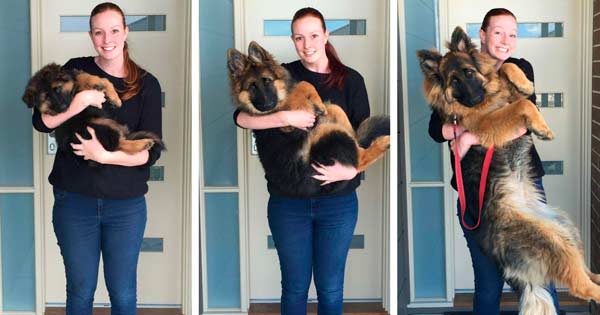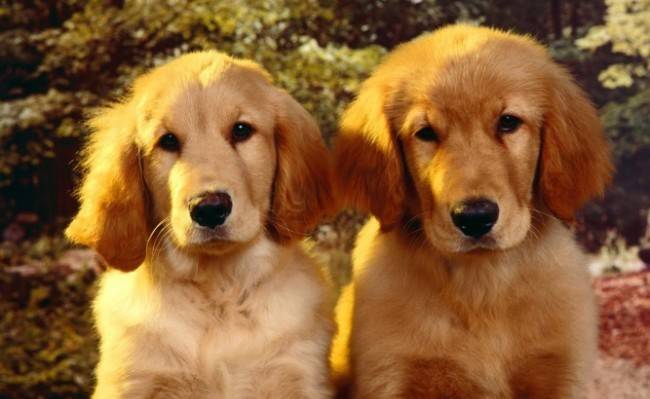As soon as an unknown origin appears in the house four-legged pet, then there are a lot of questions about how he will grow up, whom he will look like, become big or stay small. If we are talking about a thoroughbred puppy, then special difficulties there is no future exterior – you can look at his parents or other representatives of the breed. But for any dogs there are certain rules and canons of growth at different age periods. So how old are dogs?
Content
- 1. The growth of dogs of various breeds
- 2. Stages of development and growth of the dog
- 3. The period from birth to 6 months
- 4. The growth of puppies older than 6 months
- 5. Proper feeding of the puppy
Dog growth of various breeds
Contents
In most cases, puppies grow intensively up to 6 months, representatives of small breeds growth slows down earlier than in more large ones.

Puppies of large breeds grow and form after six months age, although not so fast. Consider the growth of some breeds:
- Pekingese – these small dogs grow up to an average of 9 months, males often up to a year.
- Yorkshire terriers – their growth lasts up to 7-8 months.
- Chihuahua – very small and fragile puppies grow up to 8 months, and after a year they get much stronger.
- Dachshund – puppy growth stops at 8 months, after that they continue to grow, but exclusively in breadth.
- Pug – the growth of these puppies varies – he can stop in six months or last up to 9 months, while they are intensively gaining weight.
- Rottweilers – a powerful and large breed, puppies grow to 12 months, the development of the muscle corset occurs before the 2-year-old age.
- German Shepherd – active growth is observed up to a year, and the dog is fully formed by two years.
But it is worth considering that the above data is only average numbers, because in addition to the ratio to the breed, there is still and a mass of no less important factors affecting growth and development dogs:
- proper, balanced nutrition;
- absence or presence of training;
- pet conditions;
- hereditary disposition to diseases.
It will be useful to read:
- How to determine the age of the dog
- How to determine the breed of a dog
- Pros and Cons of Dog Sterilization
Dog development and growth stages
A healthy, normally developed puppy must grow in accordance with a certain pattern. In a concept such as growth, is included several stages:
- changes in puppy weight;
- body growth;
- external changes (exterior);
- physiological features.
The concepts of growth and development have different meanings, but if the pet is healthy, then they occur in a timely manner. There are several stages of growth and development of puppies:
- The first stage is considered to be the period when the puppy is still in the womb. This period is very important, since it is there the basic qualities of the future dog are laid. And here it’s worth more carefully choose a future family member based on his parents, the reputation of breeders.
- The second stage is the time when the baby on the chest feeding, the so-called suction period, lasting from childbirth up to one and a half months. At this time, for the well-being and growth of the kids the breeder is responsible, and he bears all responsibility for the small pets. If the puppy is strong and future owners have experience feeding monthly puppies, you can wean him from his mother a little earlier to be completely sure that it is right feeding and further growth.
- The third stage is longer, lasts from 1.5 to 6 months. Most often, during this time period, puppies also appear in new the hosts. At this time, the puppy grows very intensively, he has there is a change in milk teeth. Here, already responsible for all processes solely the owner.
- The fourth stage – from 16 to 12 months, is quite diverse and proceeds depending on the breed of the puppy. It may be accompanied active growth, its slowdown or complete stop.
- The fifth stage is no longer puppy growth, but the formation processes adult, albeit young, dogs. Its duration is an average of 2-2.5 of the year. Stopping in growth, the animal continues to gain muscle mass.
It is important to have an understanding of which measurement data correspond to normal in one or another period. Of course, there are no exact figures, but still there is a certain trend.
Period from birth to 6 months
From birth to six months, a healthy active puppy should increase in weight three times, and grow at the withers – two. In it Dogs only grow tall.
This stage is characterized by cessation of growth of tubular bones. Therefore, it is very important that at this time everything is formed according to normal. Improper, unbalanced nutrition, transferred serious diseases can adversely affect development bone skeleton, as a result, deformations and obvious violations that can no longer be corrected.
In this case, the adult will have the wrong body proportions that will put an end to exhibitions and exhibits contests.
Puppies over 6 months old
In puppies from six months of age there is an increase in flat bones, that is, the breast bone is actively developing, pets are growing, but already wide. These processes intensively last about 6 months, and after a year, growth continues, but at a slower pace.
The bone frame of the dog is fully formed by the age of three. Small breeds finish developing much earlier than large ones.

The first mating affects the growth of the pet, after it growth the animal stops completely. This is one reason to avoid early episodes so as not to disrupt development and growth dogs.
For fixing metric data it is necessary to certain periods to measure the dog and record all the data. For weighing puppy can use household scales, but if the pet belongs to large breeds – St. Bernards, Caucasian Shepherds, then necessary there will be large trading scales.
In addition, the following parameters are measured:
- girth of the sternum;
- growth (height at the withers);
- length of hind and forepaws.
To remove them, use centimeter tapes, tape measures and rulers.
Before six months of age, it is recommended to measure the pet every 10 days, at a later age, once a day will be enough month.
Proper puppy feeding
Of great importance to the growth and development of the dog is its nutrition. Ideally, a diet that includes the amount of feedings dietary composition based on individual and pedigree features should be developed by a dog handler.
On average, a puppy should eat at least 5-6 times before 3 months per day. The grown up pet is gradually transferred to four feeding. From 6 months, the number of feedings can be reduced to two, as for an adult dog.
Do not forget that from six months the pet happens intense muscle gain, so a diet is necessary enrich with proteins, vitamins and minerals.
Dog owners have a choice – feed the pet natural products or prepared feeds – dry or wet. Sometimes There is a successful combination of these two types.
If the owner of the puppy chooses dry or wet feeding feed, then he must pick up a good super-premium feed. IN such products contain all important micro and macro elements, vitamins, enough proteins, fats, carbohydrates. The balance of the finished feed affects the normal puppy development. In addition, most manufacturers, releasing similar products, take into account age features and other the nuances.
Those owners who have preferred natural nutrition, must comply with the following recommendations:
- Exclude from food too spicy, fatty, smoked, salty food.
- It is best to buy marine fish, having boiled it first. IN raw fish and meat can lead to helminth infections invasions.
- Bones are poorly digested, so it is not advisable to give them bite pet.
- Sweets and chocolate lead to diabetes, disorders in cardiovascular system, loss of vision and teeth, therefore their use is excluded.
- You can give low-fat cheese, cottage cheese, boiled meat, raisins, dried fruits, etc.
- Food should be at room temperature so as not to disturb digestion process.
Proper feeding, caring and attentive to the pet will help him grow and develop normally.






